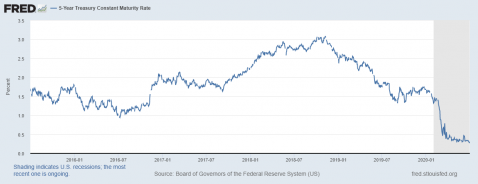
Yields on 5-year U.S. Treasury Notes remain at lows quickly reached as we entered the era of the COVID-19 pandemic. As can be seen in the chart embedded herein, these rates, most closely tracked for commercial real estate financing cost, plummeted from what were already considered low levels to under 50 basis points (0.5%), barely hovering, it would seem, over naught. Though borrowing costs have not exactly followed this point for point, it has nonetheless been an excellent development for those looking to finance; rates are indeed lower.
“Due to economic cutbacks, the light at the end of the tunnel has been turned off.”
~Author Unknown
This low rate environment is powerful for real estate as an asset class. To be sure, there are concerns about vacancy rates and rent growth in a slower economy, but lower rates, by way of cost of capital and as an alternative asset class comparison, have an offsetting positive effect. Further, vacancy and rent growth affects are as yet unknown, a known unknown. Lower interest rates, meanwhile, are a known known. One also has to wonder if some of the economic concerns in the current environment, namely the expansion of money supply, could attract money to commercial property as a store of value.
The interest rate environment has the ability to affect commercial property economics in a number of different ways (see this and this). Borrowing costs are, of course, affected directly, as higher interest rates increase the cost of borrowing and thus negatively affecting demand. Cap rates tend move over time with interest rates, but not in lockstep, with considered analyses generally concluding that capitalization rates on average move in the same direction as 10-year rates, but only about a third as much, and again not in lockstep. Interest rates also affect the economy, which in turn affects vacancy and rental rates.
